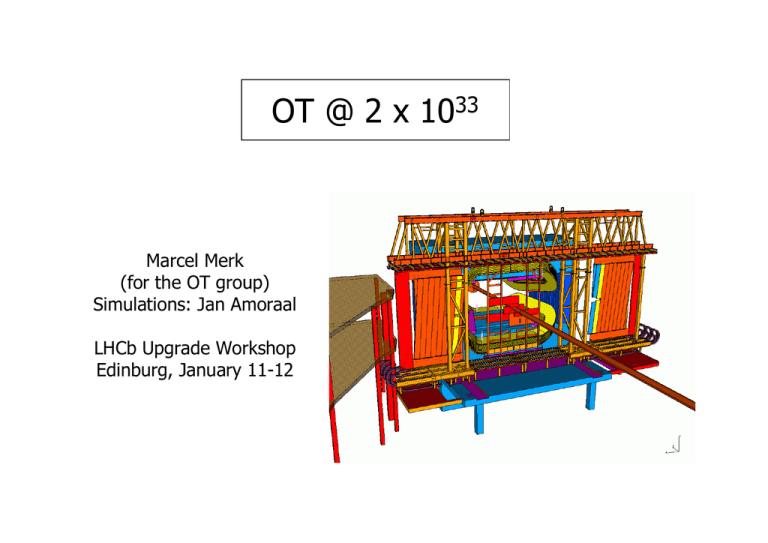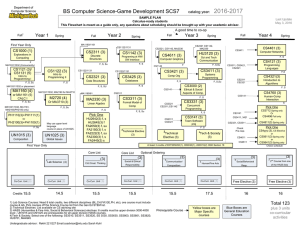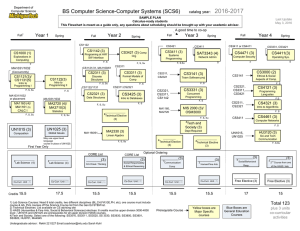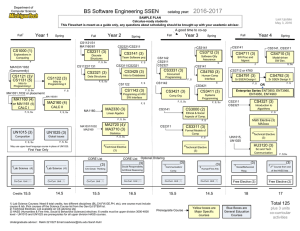OT @ 2 x 10 33 Marcel Merk (for the OT group)
advertisement

OT @ 2 x 1033 Marcel Merk (for the OT group) Simulations: Jan Amoraal LHCb Upgrade Workshop Edinburg, January 11-12 # interactions vs Lumi Particle Flux (MB events) Lumi 2 x 1032 16 000 Lumi 20 x 1032 160 000 Current in wires (MB events) Lumi 2 x 1032 I < 5 nA/cm Lumi 20 x 1032 I < 50 nA/cm Irradiation Studies @ high intensity (X-ray tube Heidelberg) However: Irradiation studies with production modules show gain reduction at low intensity. => Outgassing effect? 20 x 1032: in hottest area: Current = 50 nA/cm => 0.5 C/cm/year (1 y = 107 s) Channel accumulated charge ≈1.3 C/cm No effects seen Pos (cm) B events: Toy Model for OT spillover BX Gate: -2 -1 0 +1 +2 Assume: maximal drift time ~65 nsec (=> 2.5 BX) In this case: 1/5 of BX-2, 3/5 of BX-1, BX0, 3/5 of BX+1, 1/5 of BX+2 • For a MB event we see 1 Nint pile-up + 1.6 Nint spill-over = 2.6 Nint interactions • For a B event we see 1 B + 2.6 Nint interactions Assume further: • A minimum bias interaction produces on average ~ 20 tracks • A “B” interaction produces on average ~ 40 tracks Examples: <N int> 0.6 (2 x 1032) # tracks (MB-event) #tracks (B-event) 31 71 3 (10 x 1032) 156 196 6 (20 x 1032) 312 352 Ratio: hi:lo 352:71 = ~5 Deposits Time Spectrum (B events) The multi bunch structure leads to the typical TDC spectrum for the deposits: Lumi 2 x 1032 Lumi 20 x 1032 1 B + 0.6 pile-up + 1 spill-over : long timeof-flight tail -2 -1 0 +1 +2 1 B + 6 pile-up + 10 spill-over : Hit Efficiency The probability that an MC hit (ie. A particle passing the OT layer) leads to at least one hit in a double layer. Lumi 2 x 1032 Lumi 20 x 1032 => No large detector/readout inefficiency for high luminosity OT Times distribution The number of registered OT times in a B event Lumi 2 x 1032 Typically 3000 hits 10000 OT-times Lumi 20 x 1032 Typically 14000 hits 10000 OT-times OTTimes: MC information Lumi 2 x 1032 Lumi 20 x 1032 • 497 evts B2Jpsi(mumu)Ks (Boole v12r10) • 490 evts B2Jpsi(mumu)Ks (Boole v12r10) • 3336 OTTimes per evt (Avg. occ 6%) • 13647 OTTimes per evt (Avg. occ 25%) – Evt • • • (/) Spill 64% Primary 41% Secondary 23% Unknown 0.25% – Evt • • • (/) Spill 37% Primary 23% Secondary 13% Unknown 0.1% – Spill over 29% • 12% Next + 11% Prev + 7% (PrevPrev+NextNext) – Spill over 57% • 23% Next + 22% Prev + 12% (PrevPrev+NextNext) – Noise 7% (5% X-talk (input)) – Noise 6% (5% X-talk (input)) Occupancy per layer The average occupancy for each layer (x,u,v,x) in T1, T2, T3 Lumi 2 x 1032 T1 T2 Lumi 20 x 1032 T3 ~6% occupancy T1 T2 ~26% occupancy Ratio is ~ 1 to 4-5 compatible with the toy model Expect Occupancy @ 10 x 1032 ~ 15% T3 Occupancy vs X-coordinate Lumi 2 x 1032 Lumi 20 x 1032 40% occup 10% occup “Guesstimated” curve for 10 x 1032 • In current geometry the occupancy does not reduce fast as function of x position • 20 x 1032 : Occup up to 40% seems unrealistic with current detector geometry ⇒ Use shorter OT modules or different technology? • 10 x 1032 : Will it be possible to operate with occup up to 25%?? Considerations for 20 x 1032 • Radiation tolerance (Minimum bias) – Hard to predict ageing effect – OT technology designed for 5 x 1032 – High intensity radiation tolerance tested up to 1.3 C/cm • Equivalent to 10 years @ 5 x 1032 or 2.5 years @ 20 x 1032 • Occupancy (B events) – Occupancy a factor of 5 higher as in 2 x 1032 – Need to reduce occupancy to keep pattern recognition task comparable to current situation • Shorter OT modules by ~ 30 cm (ie a larger IT) might be a possibility… Current OT modular layout S1 Module Type F S2 S3 OT straw geometry for 20 x 1032? 150 100 200 A new OT detector! 40 IT surface ~3 m2 /layer Such a geometry reduces the irradiation and the occupancy in the OT detector to be withneeded? the design of the current detector. About 3-4 m2compatible inner tracker Questions from Ueli/Leo (1) • What is needed (replacements, upgrade) to be able to sustain 2*10**33 luminosity during 5 years concerning both electronics and mechanics (rates, occupancies, radiation damage)? ¾ Not changing the OT geometry seems to give too high rates/occupancies. ¾ OT TDR: cost OT modules: 2720 kCHF • What are the estimates of the detorioration on the physics measurement (e.g. track reconstruction, energy cluster reconstruction, electron identification) due to higher occupancies? ¾ See before: Pattern recognition with 40% occupancy seems unreasonable. A test running Brunel at high lumi with current geometry took forever… • What if the readout is performed at: – 40 MHz – 1 MHz with a factor 40 more front-end storage ¾ The OTIS can output 1 byte/25 nsec. 40 MHz requires a redesign. ¾ OT TDR: cost electronics 5570 kCHF. • Who can be seen as contact person for the upgrade? ¾ Antonio Pellegrino • Who can give the requested talk at the workshop? ¾ Anyone. Questions from Ueli/Leo (2) • Which groups are interested in an upgrade, with which manpower (and related money)? ¾ In current OT community: ¾ Need to get experience with current OT detector performance to estimate possibility with straw technology at high lumi. ¾ No money/manpower available today for large investments. ¾ My Personal Opinion: ¾ Before considering a new OT detector strong indications for new/exciting physics must be seen. End Hit Flux 2 x 1032 OTTimes per layer Lumi 2 Lumi 20 Calibrated time spectrum Lumi 2 Lumi 20 TDC spectrum







